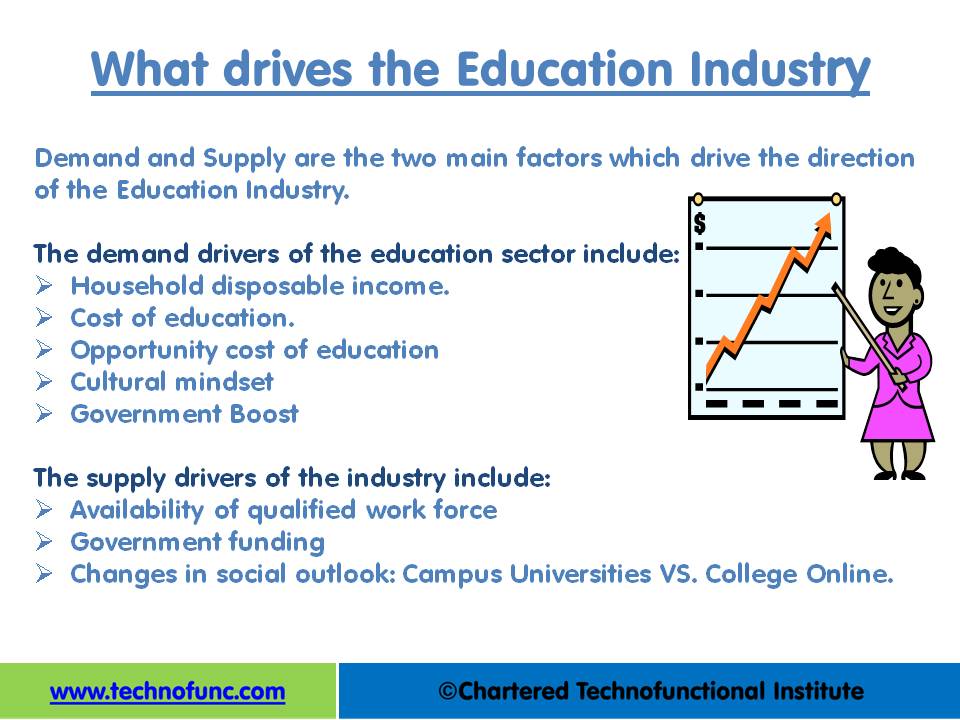- Home
- Business Processes
- Industry Knowledge
- Aerospace Industry
- Automotive Industry
- Banking Domain
- BFSI Industry
- Consumer/ FMCG Industry
- Chemicals Industry
- Engineering & Construction
- Energy Industry
- Education Domain
- Finance Domain
- Hospitality Domain
- Healthcare Industry
- Insurance Domain
- Retail Industry
- Travel and Tourism Domain
- Telecom Industry
- Leadership Skills
- eLearning
- Home
- Industry Knowledge
- Education Domain
- What drives the Education Industry
What drives the Education Industry
In the section, we will discuss the drivers of the education industry. Business drivers are influences, both internal and external, that significantly impact the direction of an industry. This will help the learner understand the internal and external factors that have a significant influence on the education industry.
Drivers of the Education Industry
Just like any other industry, the Education industry is also dependent on the forces of demand and supply. These two forces drive the growth of the education industry. There are different drivers under both the forces which drive the industry. Let us understand these business drivers in detail. Business drivers are influences, both internal and external, that significantly impact the direction of an industry. The education industry has the following key business drivers:
Household Disposable Income/ Cost of Education:
Household disposable income is the amount of income left to an individual household after taxes have been paid, available for spending and saving. People with higher disposable income opt for expensive educational institutions like international schools, world schools, etc. It’s a well-researched conclusion that cost is a big constraint associated with school attendance, thus lower the cost of education, the higher is the literacy rate. If the cost of education is high in a country, fewer people can afford it, if the cost is average more people enroll in the system.
Increased Disposable Income:
It has been established by way of various research studies conducted in the past that people with higher education levels have an improved chance of earning a high income and resulting in labor market success. If for a given country we are successful in significantly increasing the quantity of schooling, then individuals’ earnings rise as a result. Typically, rates of return to education are higher in lower-income countries and thus, increasing schooling attainment should increase labor market earnings in the future. Those who have completed a professional program are more desirable to many employers, and fewer educated people are unemployed. Generally speaking, the higher your level of education, the higher your earnings will typically be. The rate of return year to an additional year of schooling is significant in many developing countries, especially low-income countries.
Opportunity Cost of Education:
In economics, "opportunity cost" refers to the next best use of a resource. We think about opportunity costs every day as we decide how to spend our time or money. This is the cost of education measured in terms of value to the next best alternative forgone like employment. This is a key concept in economics and generally comes into the picture at professional levels. The opportunity cost of education could comprise of foregone wages, tuition, textbooks, and additional living expenses and may include the additional cost associated with a reduction in years of future labor force participation. If the value derived from pursuing education by sacrificing one’s job is greater in terms then people opt for further studies. Similarly, when it comes to government spending on educational reforms, the opportunity cost is the other ways that government could use the taxpayers' spend on the educational program, as well as the time teachers and administrators spend implementing it.
Cultural Mindset:
Since the demand for schooling is often influenced by economic, political, social, and cultural factors, in many cases it is not sufficient merely for a school to exist in order for parents to enroll children in schools. Even free education may not entice poor families. Cultural mindset plays an important role here and refers to the awareness amongst people for the need of education. For example, female education is not given due importance in remote areas. Even the level of parental education is a key determinant of their children’s educational attainment.
Government Boost:
This refers to the role played by the government to boost education amongst masses by offering incentives, awareness programs, free female education, education grants, education loans at minimal interest rates, etc. Governments around the world spend significant resources on education. While such outlays have led to a tremendous expansion of schooling, to further ensure macro-economic stability, as well as to promote equitable economic growth and literacy rates, countries need to maintain public spending at a level consistent with their long-run financing ability while, at the same time, establishing transparent budget mechanisms that allocate and manage public resources equitably for education reforms. Education expenditure by governments should pay considerable attention to the productivity and efficiency of the education sector. Determining how governments and families can best finance and allocate scarce resources to produce quality education and the skills that individuals need for success, is an integral task that impacts and drives this sector. There is a need for governments to integrate education into a country-wide perspective focusing on how education ties into the macro-economic context.
Some of the factors that drive the education industry with respect to government boost are; how much is spent on education and what is the share of the government's expenditure, how governments finance the education sector and what do they finance, and if the spending is adequate and sustainable.
Demand Side Financing:
Demand-side financing is the principle of channeling education resources through students and their parents or basing school funding on enrolments or attendance has been proposed for a number of reasons in different countries. Supply-side financing usually refers to funding inputs such as human and material resources based on formal sector planning by technical planners and managers. However, ensuring the supply side is, in many cases, not enough. Thus, there may be good equity and access reasons to consider demand-side financing. The focus is on putting the resources in the hands of those who demand education and not those who supply it. The goal is to bring down the barriers that prevent children from continuing their education. Some examples of demand-side financing programs are scholarships, targeted vouchers, and conditional cash transfers.

Qualified Workforce:
Establishing a strong education system requires the availability of a qualified workforce who can impart quality education to the people. It is useful to combine with quality interventions such as compensatory education, teacher training, or female empowerment, among other interventions. Lifelong learning gives people access to basic formal education and then provides them with opportunities to update their skills and knowledge. Institutions are set up so they can quickly adapt to changing educational needs. Lifelong learning fulfills two key objectives. First, it produces a large number of people with a standard level of knowledge, which is vital for a nation to stay competitive economically. Second, it allows each person's knowledge base to grow. This is necessary for an economy where things change at a rapid pace.
Educational Infrastructure:
To accommodate the school-going population, it requires a strong educational infrastructure in order to keep pace with the developing economy/population and provide it with quality manpower. Education can accelerate economic growth and investment is a key indicator to expand and improve the quality of education. Thus education requires an investment in creating educational infrastructure, which can lead to good quality education. Huge investments are required to establish rich infrastructures. With the help of government funding, it becomes easier to build affordable education centers.
Information Technology:
With the onset of online methods of education, the social outlook has shifted focus from concrete structure to virtual and online education. Higher education and research institutes have imbibed IT because their level of sophistication demands a high level of automation and IT infrastructure. IT solutions offer advanced campus Management System is like a digital campus, where admin can monitor everything from faculty to infrastructure on a daily basis.
Globalization of Education:
International trade in higher education services has grown rapidly in recent years in a variety of forms. Globalization has had a profound effect on the world's economies. But it's also had a significant impact on the education industry. In the past, it was sufficient for many countries to supply low-wage workers to spur national growth and prosperity. However, intense global competition and technological change have created advantages for countries that have a well-educated and skilled workforce. The most common form of this trade is the movement of students to study in foreign universities, which has been supplemented by the delivery of foreign higher education programs and institutions to transition in developing countries. Among the factors propelling demand for foreign higher education services is the excess demand for domestic higher education and the need for internationally recognized qualifications in emerging regional and global markets for highly skilled labor.
Societal Benefits:
Higher education provides a number of societal benefits. For instance, employed people provide higher tax revenues and increased productivity, which benefits everyone. Education contributes to social benefits, such as consumers that are more informed, technological progress, better health outcomes, and so on. Education is also important to economic growth and poverty reduction and contributes to the reduction of child labor, increased educational attainment, and improved health and nutrition for the poor. The implication is clear that increasing the accumulation of education by the poor will increase their incomes and well-being. Therefore, the social benefits of education have a direct relation with macro future earnings gains and when more people are consistently employed, the need for national support programs decreases.
Related Links
You May Also Like
-
Importance of Education Industry
Nelson Mandela has said, “Education is the most powerful weapon which you can use to change the world.” The following article touches on some aspects that highlight the importance of education industry for human society.
-
The education industry is divided up into four sectors, which all have their own roles and functions. Each of the sectors caters to a growing demand for cutting-edge education products and services. Each category has distinct market segments, all of which are defined in this article below. For learners to understand the dynamics of the education industry, having a clear picture of the industry is crucial. This understanding will help in researching education companies, determining a career path, and even exploring potential employers.
-
History of Education & Its Growth as an Industry
Education in its general sense is a form of learning in which knowledge, skills, and habits of a group of people are transferred from one generation to the next through teaching, training, research, or simply through autodidacticism. This article takes you through the history of education and its development as an industry.
-
Challenges in Education System
The Education sector underwent some major changes over the past five years. Enrolment in private schools outpaced government school enrolment for much of the period. Tutoring businesses and universities have offered new services to expand their market base. Online education is a major development for the Education Division, and technology is permeating all areas of education. Understand some of the major challenges that are faced by the education sector today.
-
Different governments and different standards classify levels of education differently. There is a difference in nomenclature that is in practice today. However, for the purpose of simplicity, all classifications can be mapped to the grid provided in this article. Given below are commonly used different levels in the education process.
-
The education industry is expanding rapidly and its many businesses are eager for new talent, including experienced professionals and enthusiastic individuals just entering the workforce. The education industry can be described as the collection of organizations and businesses that provide products and services aimed at enhancing the quality of education in society. Read more to gain a complete overview of the education industry.
-
How to Improve Education System
The education industry today is faced with many challenges, and in order to improve the education system and the performance and development of the education industry, the major improvement must be made in the sector. This article discusses the major components that need to be worked upon to create an effective improvement strategy.
-
What drives the Education Industry
In the section, we will discuss the drivers of the education industry. Business drivers are influences, both internal and external, that significantly impact the direction of an industry. This will help the learner understand the internal and external factors that have a significant influence on the education industry.
Explore Our Free Training Articles or
Sign Up to Start With Our eLearning Courses

About Us
Learning
© 2023 TechnoFunc, All Rights Reserved








